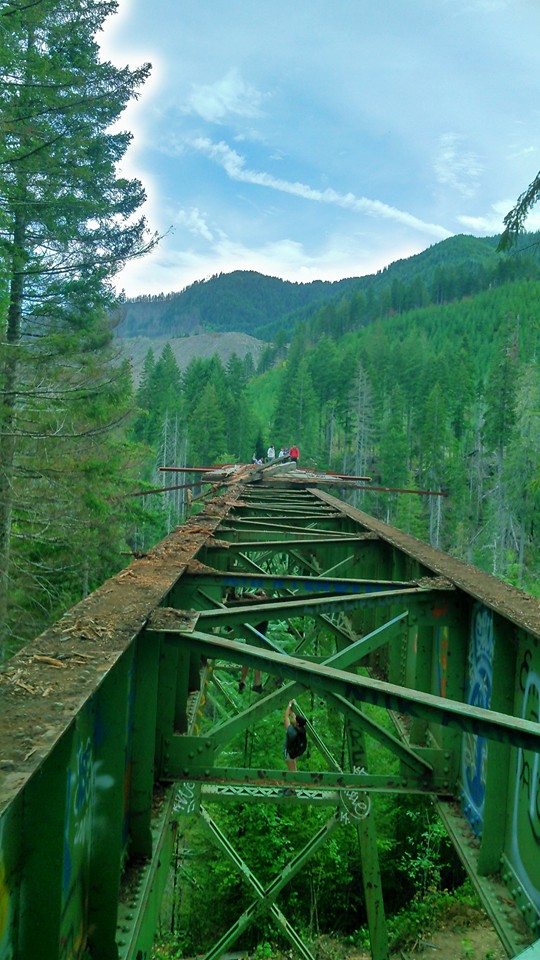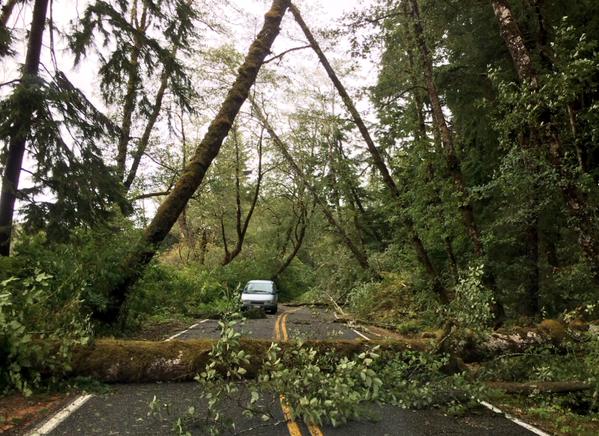In the remote stretches of Mason County, out near the wilderness regions of the Olympic Peninsula, a historical structure is quietly being destroyed, one board at a time. What should be a major attraction to the area, the picturesque Vance Creek railroad bridge, spanning a forested creek, is being destroyed in secret. You can blame the trespassers, you can blame out of town vandals, but at the end of the day, we might have to start blaming the land owners. You are sitting on a tourism gold mine and instead of being a people-friendly company, you are appearing out of touch. Keeping this historical wonder to yourselves is an outdated way of thinking. You could turn this into a tourist destination, like British Columbia’s Kinsol Trestle and show that you are a company that cares about the region’s historical landmarks. Instead, we get silence.
Update: Green Diamond has responded to this post, which can be read here.
History is something we should cherish and share, as it shows where we came from and how we used to be. That is how I feel about historical structures in the Pacific Northwest, like the Enchanted Valley Chalet and the Vance Creek Bridge. The former is currently awaiting its fate, decided by the people of the Pacific Northwest and the National Parks. It is a cornerstone of our history and needs to be saved in some way, shape or form for future generations to marvel over. The Vance Creek Bridge is privately owned, off limits and its fate rests in a private business. Yes, the area has slowly been destroyed by trespassers, drunk locals, vandals, fires and out of town visitors. The trespassers who have visited Vance Creek have been assholes, starting small fires, leaving tons of trash and acting like irresponsible jerks. If I owned the area, I’d be pissed off too. I wouldn’t want my property being ruined and people risking their lives taking silly pictures, but I also don’t think I would just start taking it apart. Yes, the area is dangerous and you could be sued if someone gets hurt on your land. I fully understand that. Your insurance must be through the roof for this bridge and the popularity would be infuriating. However, removing boards isn’t going to stop people from coming. In fact, it only increases the risk of an injury.
History is apparently not that important to many in the Pacific Northwest, and this bridge is a great representation of this. We should be protecting this bridge, showcasing the lumber history of Mason County and celebrating human achievements, but after a fire in early July of 2016, the bridge is more than likely vanishing. The fire is rumored to have damaged boards, which were recently ripped off and removed. Numerous sources have tried contacting the land owner to see how much damage occurred, to no reply.
The Vance Creek Bridge is full of history. Sitting 347 feet above Vance Creek, the Vance Creek Bridge is said to be the second highest railway arch bridge ever built in the United States. At 422 feet long, this bridge was originally built in 1929, along with the nearby High Steel Bridge, to help the logging industry in Mason County. While the High Steel bridge was paved over and used as a Forest Service Road, the vance Creek Bridge was kept private, accessed illegally by locals over the years. Once social media started showcasing this majestic bridge, the region blew up in popularity, forcing the land owners to start charging trespassers. Despite the rumors of felony trespassing charges, people from around the world still came to see Vance Creek Bridge and be dumbfounded by this engineering marvel. Now, with boards removed and the risk of injury even higher than before, we will soon only have our Instagram posts to look at. Our memories of walking this bridge and experiencing the awe of nature from above the trees, will stay in our minds, but future generations may never see this stunning sight.
On August 28th, 2016, an Outdoor Society reader went to the Vance Creek Bridge to remove nearly a ton of trash from the area. They discovered the bridge to be missing numerous boards, leaving the bridge to now look like this:



I have been hard on the land owner (Green Diamond) in this article, but I will explain why. As I mentioned before, I totally understand why they are doing what they are doing, but this isn’t their only option. Yes, the fire damaged a section of the bridge and that truly sucks. It is inexcusable, reckless and I hope whoever started the fire faces charges. However, the area is an absolute gold mine for tourism. With proper safety infrastructure and repairs, the Vance Creek Bridge could become Mason County’s version of the Capilano suspension bridge. It could become a State Park, or it could become a zip-line course. It might as well be all three!
It can be anything, with an investment by the local community, the state or even by the land owners. Is the money there? Who knows, but isn’t it worth trying out? Wouldn’t you want you company to have a positive reputation in the region, instead of one of distrust and anger? You could use the region to highlight your environmentally-friendly and sustainable logging practices. You could create displays and informative boards talking about the area’s logging history. You can make this an amazing place for families to visit and say “Thanks Green Diamond, I love what you do.” Or, you can keep it private and tear out all the boards and keep handing out tickets, while the residents of the cities around the PNW (who you used to employ) wonder why you are ruining this gem of the Olympic Peninsula.
To think that patrols in the area and tickets for trespassing will stop visitors from experiencing this historical and breathtaking bridge is ludicrous. To think that removing boards will stop people from visiting the Vance Creek Bridge is shortsighted and makes a slightly dangerous area even more dangerous. Now, instead of walking on old boards, the throngs of visitors who don’t give a flying fuck if they are trespassing are going to walk on the narrow and slick steel beams until they reach the boards.
The Vance Creek Bridge needs to be saved, protected, restored and open to the public.
If you can’t do this, Green Diamond, maybe it is time to sell it to someone who will.



